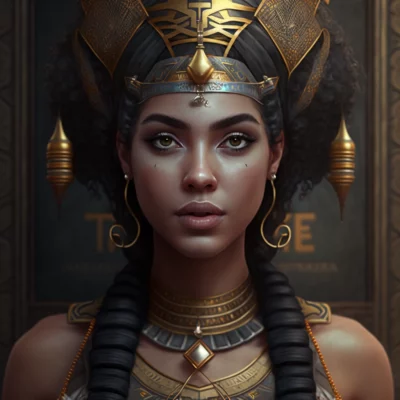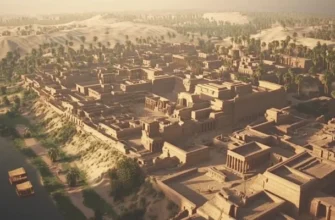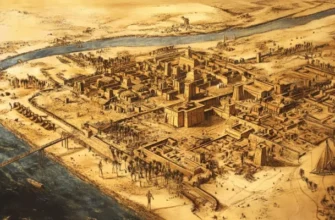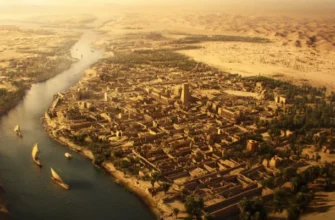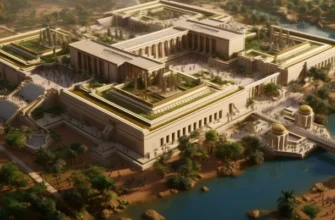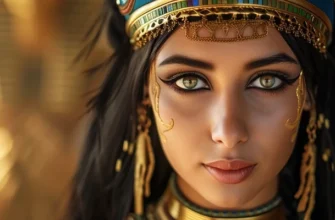The Egyptian goddess Anuket was a prominent deity worshipped in the ancient world. Her history and cult have been the subject of much research and study over the years, revealing important information about the beliefs and practices of the ancient Egyptians.
The Egyptian goddess Anuket was a symbol of the Nile River and water in ancient Egyptian mythology. She was depicted as a woman with a crown, where a water face mask symbolized her power over water resources. The goddess played an important role in the religion and culture of ancient Egypt, where her cult was quite widespread.
Anuket was associated with the Nile River and could influence its floods. She also protected the borders and was the patroness of military affairs. In her most popular temple in the city of Esna, she was represented together with her husband, the god Khnum, who symbolized the river’s currents.
The Egyptian goddess Anuket has left a great mark on the history of Egypt and has a significant influence on modern culture. Her image can be found in various art forms, such as sculpture, paintings, and other decorative arts. In addition, she has become one of the favorite subjects of movies, books, and games, which allows her cultural heritage to exist to this day.
- The story of the goddess Anuket
- Origin of the goddess Anuket
- Images and symbolism
- The role of the goddess Anuket in the history of Egypt
- The cult of the goddess Anuket
- Rites and rituals in honor of the goddess Anuket
- Famous temples and shrines
- The importance of the goddess Anuket for Egyptian society
- Researching the cult of the goddess Anuket
- Sources used for the research
- Modern research and information about Anuket
- Influence on culture and modernity
- Conclusions.
The story of the goddess Anuket
Origin of the goddess Anuket
The origins of the goddess Anuket, also known as Anukis, daughter of Khnum and Satis, ruler of Hel, one of the islands of the archipelago near the first Nile Rapids, date back to the pre-dynastic period in ancient Egypt, and she was originally associated with the Nile River and hunting. Over time, it evolved and became associated with the concept of fertility and motherhood. Anuket was revered as a powerful goddess who was responsible for ensuring the annual flooding of the Nile River, which was crucial for the agricultural fertility of the land.
The Egyptian goddess Anuket was a symbol of the Nile River and water in ancient Egyptian mythology. She was depicted as a woman with a crown, where a water face mask symbolized her power over water resources. The goddess played an important role in the religion and culture of ancient Egypt, where her cult was quite widespread.
Anuket was associated with the Nile River and could influence its floods. She also protected the borders and was the patroness of military affairs. In her most popular temple in the city of Esna, she was represented together with her husband, the god Khnum, who symbolized the river’s currents.
The Egyptian goddess Anuket has left a great mark on the history of Egypt and has a significant influence on modern culture. Her image can be found in various art forms, such as sculpture, paintings, and other decorative arts. In addition, she has become one of the favorite subjects of movies, books, and games, which allows her cultural heritage to exist to this day.
Images and symbolism
Anuket was usually depicted wearing a tall helmet with a feather on top, symbolizing her power over water. Sometimes she was depicted with a wedding dress and a feathered fan, emphasizing her feminine beauty and power over fertility.
The image of the goddess Anuket has several standard elements that help to recognize her among other deities of Egyptian mythology. Usually, she is depicted as a woman with a boat on her head, on which a tall crown of feathers is placed, symbolizing her power over the river. Sometimes she is also depicted with poles symbolizing her protective role.
Also, Anuket is often depicted as a young and beautiful woman with a tall feather crown and a dove on her head, symbolizing peace. Sometimes she holds a fishing net or is depicted with a hunting weapon, symbolizing her role as a goddess who provides food and health to her worshippers.
The symbolism of the goddess Anuket is associated with the Nile River and agriculture. She was the patroness of waterways and brought harvests to farmers. She was also considered a goddess of the afterlife who helped the dead. In some myths, she is mentioned as the wife of the god Khnum, who was an important river god and the creator of the human race.
In general, the image and symbolism of the goddess Anuket reflects her power over the Nile River, which played an important role in the life and culture of the Egyptians. She was an important deity who helped to provide the population with water and food, as well as ensure peace in the afterlife.
The role of the goddess Anuket in the history of Egypt
Anuket played a significant role in the history of Egypt, particularly in the religion and mythology of the ancient Egyptians. She was one of the goddesses considered to be part of the Elephantine triad, along with Satis and Khnum. This group of deities was highly revered by the ancient Egyptians, who believed that the goddess Anuket was responsible for providing the Nile River with annual floods and the water necessary for agriculture.
The cult of the goddess Anuket
The festival of Anuket was held every year in the month of Khatur (November-December), when the Nile River began to flood the land. At this time, believers offered sacrifices to the goddess and performed religious rites.
The cult of the goddess Anuket was especially widespread in the city of No-Amon, where her sanctuary was located on the northern bank of the river. Here she was revered as the patroness of water and fishing.
In the town of Sekhet Gor Antiu, the daytime cult of Anuket was connected with the cult of Khnum, a deity who, according to one version of the myth, created people from clay on a potter’s wheel. This connected Anuket with the symbolism of water and clay.
Anuket was also revered in southern Fayum, where her name was translated as “watering”. Her sanctuary here was connected to a water source that was used to irrigate the field.
The Anuket cult used cypress branches to symbolize the vegetation in the river. Its priests performed rituals related to water and fishing, as well as the manufacture of clothing that reflected the symbolism of the goddess.
Egyptian mythology leaves its mark on culture and modernity. The images of goddesses and gods are used in art, literature, cinema and other areas of culture. The symbolism of the goddess Anuket, as the patroness of water and fishing, can be used in modern environmental and conservation projects.
At the same time, preserving the historical and cultural heritage associated with mythology is an important task in preserving the identity of peoples and nations.
Rites and rituals in honor of the goddess Anuket
Anuket was worshipped as the goddess of the Nile, as well as the goddess of fertility. Her cult was centered in the southern city of Elephantine, where a temple was built in her honor. The temple was dedicated to the worship of Anuket and the god Khnum, who was believed to have created the Nile. Ceremonies and rituals in honor of Anuket included offerings of food, incense, and drink, as well as festivals that celebrated the Nile’s floods and the goddess’ role in ensuring the fertility of the land.
Famous temples and shrines
The most famous temples of Anuket are the temple in Kom Ombo, which was built during the Ptolemaic dynasty, and the temple in the city of Esna, founded in the era of Ancient Egypt.
The goddess Anuket was worshipped in many temples and shrines in Egypt, especially in Osim, where her cult was most widespread.
One of the famous temples of Anuket was the temple in Nob, a city southwest of Memphis. This temple was built in the time of Ancient Egypt and contained a shrine dedicated to the goddess Anuket. There were also temples of Anuket in Farsal and Elephantine.
The temples of Anuket had a significant cultural and religious influence on the people of Egypt. Many of these temples had unique architecture and decorative paintings that were decorated with images of the goddess Anuket and other deities. Some of these shrines have survived to this day and are open to visitors as tourist attractions.
The importance of the goddess Anuket for Egyptian society
Anuket was considered one of the most important goddesses in Egypt, as her cult was closely linked to the life-giving Nile River. She played a crucial role in the religious beliefs and everyday life of the ancient Egyptians, as the Nile was the source of life for the entire country. The goddess was also associated with fertility and abundance of crops, making her an important figure for Egypt’s agricultural society. The goddess was also depicted in art and literature, and her name was often mentioned in prayers and incantations.
Researching the cult of the goddess Anuket
Sources used for the research
Sources used to research the cult of Anuket include ancient texts, inscriptions, and artifacts found in temples and tombs, as well as accounts by ancient writers and historians such as Herodotus and Plutarch. Many of these sources were found in the temple of Anuket in Elephantine, which provided valuable information about the goddess and her role in Egyptian society. Modern research has provided additional information about the cult and beliefs of the ancient Egyptians. Research has been conducted on rituals and ceremonies in honor of the goddess, as well as the role she played in the religious beliefs of the ancient Egyptians.
Modern research and information about Anuket
Information on modern research and study of the cult of Anuket is limited, as modern research in Egyptian archaeology and history tends to focus on the more well-known gods of ancient Egypt, such as Ra, Osiris, and Horus. However, Anuket remains an important figure in the study of ancient Egyptian religion and mythology, and her cult played an important role in the development of Egyptian religion and beliefs.
Influence on culture and modernity
Anuket has become one of the main symbols of ancient Egyptian mythology and culture, and her influence can be seen in art, where she is depicted in various types of paintings and sculpture. Anuket has also found her place in popular culture, where she is often mentioned as a symbol of female beauty and power over nature.
Although the cult of the goddess Anuket no longer exists, her images and symbolism still have an impact on contemporary culture. Images of the goddess can be found on various artifacts found during archaeological excavations, such as stone tablets, statuettes, and treasures.
Also, many famous cultural works were inspired by the goddess Anuket. For example, she was depicted in the novels Anubis’ Gate and The Amulet of Death by the famous British writer Tony Gillerman. The goddess can also be found in games and movies related to the mythology of Ancient Egypt.
Thus, the goddess Anuket remains an important element of the culture and mythology of Ancient Egypt, and her images and symbolism continue to influence modern culture.
Conclusions.
The Egyptian goddess Anuket played an important role in ancient Egyptian mythology and culture. Her power over the Nile River and water resources was reflected in religious rites and festivals, and her symbolism became an important element of ancient Egyptian art. Today, Anuket remains an important part of Egypt’s cultural heritage and a monument of global significance.
The Egyptian goddess Anuket is an important figure in the mythology of ancient Egypt, symbolizing water and the Nile River. She was depicted as a woman with crowns consisting of a feather and a pole, which symbolizes power over water.
Knowledge of the goddess Anuket allows us to better understand the culture of ancient Egypt and its beliefs. She is an important figure in the history of the world and continues to arouse people’s interest to this day.
The study of the goddess Anuket and her cult is an important area of research that provides valuable information about the beliefs and practices of the ancient Egyptians. The importance of studying this topic lies in the opportunity to understand the religious beliefs and practices of a complex and fascinating civilization. The prospects for further research in this area are promising as new discoveries and information continue to emerge.
